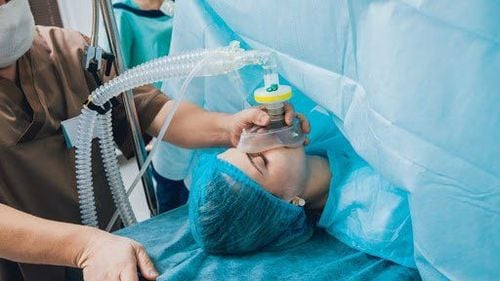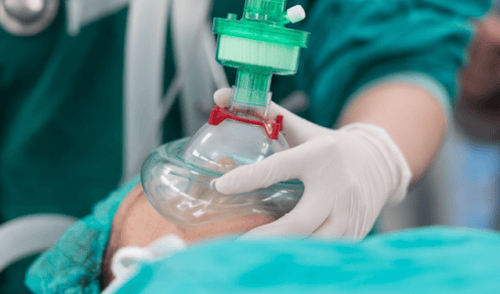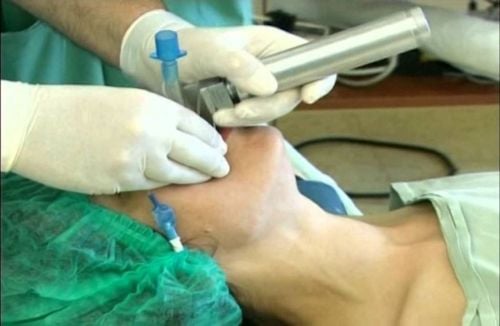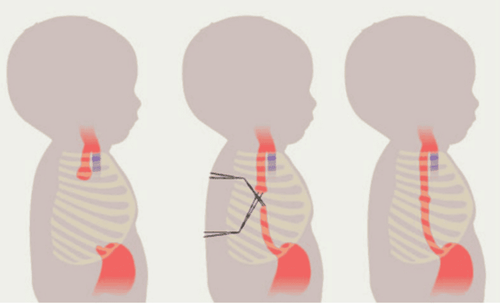This is an automatically translated article.
The article was professionally consulted by Specialist Doctor I Nguyen Duc Thong - Anesthesiologist - General Surgery Department - Vinmec Danang International Hospital. The doctor has 14 years of experience in the field of Anesthesia.In esophageal-tracheal fistula surgery, endotracheal anesthesia is a technique performed with a strict procedure to ensure successful treatment for the patient.
1. What is an esophageal fistula?
Esophageal-tracheal fistula is a birth defect that occurs when a fetus is forming in the mother's womb.Specifically, initially, the trachea and esophagus are a single tube. Four to eight weeks after conception, a septum forms between the trachea and esophagus, separating them into two separate tubes.
If the septum is not formed properly, an esophageal-tracheal fistula can occur. With an abnormal opening between the esophagus and trachea, fluids can pass through the fistula, enter the child's lungs, cause pneumonia and many other health problems.
Common symptoms of esophagitis are: White foam or bubbles in the mouth; vomiting; cough or choke when eating; pale skin (especially when fed); shortness of breath; abdominal distension and distention.
To treat an esophageal-tracheal fistula, surgery, separation and repair of the trachea and esophagus are required. If the ends of the esophagus are too far apart, the surgeon can use a piece of tissue from the large intestine to join the esophagus.
2. What is endotracheal anesthesia?
Endotracheal anesthesia is a technique of general anesthesia, in which an endotracheal tube is placed to maintain the ventilation of the airways, making it easy to aspirate the trachea. At the same time, control the patient's respiratory status during surgery and postoperative recovery.During the procedure, the patient will lose sensation and temporarily lose consciousness due to anesthesia but can still breathe on their own or breathe with ventilator support through an endotracheal tube.

3. Surgical anesthetic method for tracheoesophageal fistula ligation
3.1 Indications and contraindications Indications: Surgical cutting and ligation of tracheoesophageal fistula; Relative contraindications: The patient does not consent to the procedure, does not have adequate anesthetic and resuscitation facilities, or the medical staff is not technically proficient. 3.2 Preparation for implementation Personnel: Doctors, nurses specializing in anesthesiology and resuscitation. Technical facilities: Anesthesia machine system with breathing, equipment to monitor vital functions (pulse, electrocardiogram, blood pressure, oxygen saturation, breathing rate, temperature), monitor anesthesia Entropy, monitor level muscle softener (TOF), hand squeeze oxygen source, defibrillator, suction machine, laryngoscope, suction tube, endotracheal tube of all sizes, mask, balloon, canul, soft mandrin, Magill pliers. Salbutamol spray, Lidocaine 10% spray, means to prevent difficult intubation. Patients: Get detailed instructions on techniques to coordinate with doctors; be examined for anesthesia before surgery to detect and prevent risks; evaluated difficult intubation; If necessary, sedation can be used from the night before surgery. Patients need to fast completely 8 hours before surgery, stop drinking formula milk or liquid porridge 6 hours before surgery, stop drinking breast milk 4 hours before surgery, stop drinking water 2 hours before surgery. Medical records: Complete according to regulations of the Ministry of Health. 3.3 Carry out the technique Step 1: Check the records and the patient, make sure the right person, the right disease.Step 2: Patient position: Lie on your back, breathe 100% oxygen 3 - 6 liters/minute at least 5 minutes before induction of anesthesia; fitted with a monitor; Establish an effective line and premedicate if necessary.
Step 3: Initiating anesthesia: Give the patient sleeping pills (intravenous anesthetics, volatile anesthetics), pain relievers, muscle relaxants. The condition for endotracheal intubation is that the patient sleeps deeply and has enough muscle tenderness.
Step 4: Intubation
Step 5: Maintain anesthesia using volatile or intravenous anesthetics, analgesics, and muscle relaxants. Simultaneously, control the patient's breathing with a ventilator or hand squeeze; monitoring the depth of anesthesia based on heart rate, blood pressure, sweating, tearing,... In parallel, monitoring the patient's vital signs such as heart rate, blood pressure, EtCO2, SpO2, monitor anesthesia Entropy, monitor muscle tenderness (TOF), body temperature; Pay attention to prevent the endotracheal tube from being placed in the wrong position or being folded or blocked.
Step 6: Criteria for extubation: The patient is awake, following the doctor's orders; the patient can raise his head for more than 5 seconds; spontaneous breathing, respiratory rate within normal limits; Stable pulse and blood pressure, body temperature over 35°C, Entropy from 90-100, TOF muscle relaxation >90%, no anesthetic and surgical complications.
3.4 Complications and management measures Gastric reflux into the airways : Signs are digestive juices in the oral cavity and airways of the patient. The treatment is to drain the fluid, let the patient lie down with his head low, tilt his head to one side; Place the endotracheal tube quickly, remove the fluid in the airway; Monitor and prevent the risk of lung infection after surgery. Hemodynamic disorders: Patients may have hypertension or hypotension, cardiac arrhythmias (arrhythmia, tachycardia, bradycardia). Depending on the symptoms, there will be an appropriate treatment plan. Intubation is not possible: The solution is to perform a difficult intubation procedure with a flexible endotracheal tube. Intubation wrongly into the stomach: Detected by auscultation of the lungs, no alveolar murmurs and no measurement of EtCO2. To overcome, it is necessary to re-intubate the endotracheal tube with correct technique. Trauma during endotracheal intubation: Patients may experience bleeding lips, broken teeth, falling foreign bodies into the airways or damage to the vocal cords. Treatment depends on the injury. Vocal - tracheobronchial spasm: Recognized by symptoms of difficulty or inability to ventilate, auscultation of the lungs with rales or complete silence. The treatment is to provide adequate oxygen to the patient, inject more sleeping pills and muscle relaxants, give bronchodilators and corticosteroids, and ensure ventilation. In case the patient's breathing cannot be controlled, the patient will be transferred to the difficult intubation procedure. Respiratory complications: Fold or retract the endotracheal tube or open the respiratory system, running out of oxygen sources, ... leading to hypoxia and hypercapnia. The appropriate intervention method is to immediately ensure ventilation, provide 100% oxygen and find a way to solve the cause of the above complications. Complications after extubation: include respiratory failure, sore throat hoarseness, inflammation of the upper respiratory tract, laryngotracheal stenosis, laryngotracheobronchial spasm. Treatment measures depend on the cause and symptoms of these complications.

Please dial HOTLINE for more information or register for an appointment HERE. Download MyVinmec app to make appointments faster and to manage your bookings easily.














